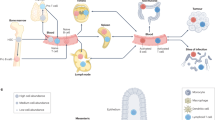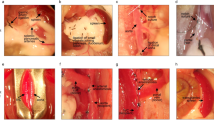Abstract
Stromal cells play an important role in the formation of the normal organized microarchitecture of secondary lymphoid organs. Here we demonstrate that a tissue-engineered, lymphoid tissue–like organoid, which was constructed by transplantation of stromal cells embedded in biocompatible scaffolds into the renal subcapsular space in mice, had an organized tissue structure similar to secondary lymphoid organs. This organoid contained compartmentalized B-cell and T-cell clusters, high endothelial venule-like vessels, germinal centers and follicular dendritic cell networks. Furthermore, the organoid was transplantable to naive normal or severe combined immunodeficiency (SCID) mice, and antigen-specific, IgG-isotype antibody formation could be induced soon after intravenous administration of the antigen. This simplified system of lymphoid tissue–like organoid construction will facilitate analyses of cell-cell interactions required for development of secondary lymphoid organs and efficient induction of adaptive immune responses, and may have possible applications in the treatment of immune deficiency.
This is a preview of subscription content, access via your institution
Access options
Subscribe to this journal
Receive 12 print issues and online access
$209.00 per year
only $17.42 per issue
Buy this article
- Purchase on Springer Link
- Instant access to full article PDF
Prices may be subject to local taxes which are calculated during checkout




Similar content being viewed by others
References
Fu, Y.-X. & Chaplin, D.D. Development and maturation of secondary lymphoid tissues. Annu. Rev. Immunol. 17, 399–433 (1999).
Nishikawa, S.-I., Hashi, H., Honda, K., Fraser, S. & Yoshida, H. Inflammation, a prototype for organogenesis of the lymphopoietic/hematopoietic system: Commentary. Curr. Opin. Immunol. 12, 342–345 (2000).
Mebius, R.E. Organogenesis of lymphoid tissues. Nat. Rev. Immunol. 3, 292–303 (2003).
Ansel, K.M. & Cyster, J.G. Chemokines in lymphopoiesis and lymphoid organ development. Curr. Opin. Immunol. 13, 172–179 (2001).
Cyster, J.G. Chemokines and cell migration in secondary lymphoid organs. Science 286, 2098–2102 (1999).
De Togni, P. et al. Abnormal development of peripheral lymphoid organs in mice deficient in lymphotoxin. Science 264, 703–707 (1994).
Banks, T.A. et al. Lymphotoxin-α-deficient mice. Effects on secondary lymphoid organ development and humoral immune responsiveness. J. Immunol. 155, 1685–1693 (1995).
Koni, P.A. et al. Distinct roles in lymphoid organogenesis for lymphotoxins α and β revealed in lymphotoxin β-deficient mice. Immunity 6, 491–500 (1997).
Fütterer, A., Mink, K., Luz, A., Kosco-Vilbois, M.H. & Pfeffer, K. The lymphotoxin β receptor controls organogenesis and affinity maturation in peripheral lymphoid tissues. Immunity 9, 59–70 (1998).
Rennert, P.D., Browning, J.L., Mebius, R., Mackay, F. & Hochman, P.S. Surface lymphotoxin α/β complex is required for the development of peripheral lymphoid organs. J. Exp. Med. 184, 1999–2006 (1996).
Rennert, P.D., James, D., Mackay, F., Browning, J.L. & Hochman, P.S. Lymph node genesis is induced by signaling through the lymphotoxin β receptor. Immunity 9, 71–79 (1998).
Endres, R. et al. Mature follicular dendritic cell networks depend on expression of lymphotoxin β receptor by radioresistant stromal cells and of lymphotoxin β and tumor necrosis factor by B cells. J. Exp. Med. 189, 159–168 (1999).
Ngo, V.N. et al. Lymphotoxin α/β and tumor necrosis factor are required for stromal cell expression of homing chemokines in B and T cell areas of the spleen. J. Exp. Med. 189, 403–412 (1999).
Luther, S.A., Tang, H.L., Hyman, P.L., Farr, A.G. & Cyster, J.G. Coexpression of the chemokines ELC and SLC by T zone stromal cells and deletion of the ELC gene in the plt/plt mouse. Proc. Natl. Acad. Sci. USA 97, 12694–12699 (2000).
Gunn, M.D. et al. Mice lacking expression of secondary lymphoid organ chemokine have defects in lymphocyte homing and dendritic cell localization. J. Exp. Med. 189, 451–460 (1999).
Vassileva, G. et al. The reduced expression of 6Ckine in the plt mouse results from the deletion of one of two 6Ckine genes. J. Exp. Med. 190, 1183–1188 (1999).
Nakano, H. & Gunn, M.D. Gene duplications at the chemokine locus on mouse chromosome 4: multiple strain-specific haplotypes and the deletion of secondary lymphoid-organ chemokine and EBI-1 ligand chemokine genes in the plt mutation. J. Immunol. 166, 361–369 (2001).
Gunn, M.D. et al. A chemokine expressed in lymphoid high endothelial venules promotes the adhesion and chemotaxis of naive T lymphocytes. Proc. Natl. Acad. Sci. USA 95, 258–263 (1998).
Okada, T. et al. Chemokine requirements for B cell entry to lymph nodes and Peyer's patches. J. Exp. Med. 196, 65–75 (2002).
Baekkevold, E.S. et al. The CCR7 ligand ELC (CCL19) is transcytosed in high endothelial venules and mediates T cell recruitment. J. Exp. Med. 193, 1105–1111 (2001).
Ebisuno, Y. et al. Cutting edge: the B cell chemokine CXC chemokine ligand 13/B lymphocyte chemoattractant is expressed in the high endothelial venules of lymph nodes and Peyer's patches and affects B cell trafficking across high endothelial venules. J. Immunol. 171, 1642–1646 (2003).
Kratz, A., Campos-Neto, A., Hanson, M. & Ruddle, N. Chronic inflammation caused by lymphotoxin is lymphoid neogenesis. J. Exp. Med. 183, 1461–1472 (1996).
Fan, L., Reilly, C.R., Luo, Y., Dorf, M.E. & Lo, D. Cutting edge: ectopic expression of the chemokine TCA4/SLC is sufficient to trigger lymphoid neogenesis. J. Immunol. 164, 3955–3959 (2000).
Chen, S.C. et al. Ectopic expression of the murine chemokines CCL21a and CCL21b induces the formation of lymph node-like structures in pancreas, but not skin of transgenic mice. J. Immunol. 168, 1001–1008 (2002).
Luther, S.A., Lopez, T., Bai, W., Hanahan, D. & Cyster, J.G. BLC expression in pancreatic islets causes B cell recruitment and lymphotoxin-dependent lymphoid neogenesis. Immunity 12, 471–481 (2000).
Luther, S.A. et al. Differing activities of homeostatic chemokines CCL19, CCL21, and CXCL12 in lymphocyte and dendritic cell recruitment and lymphoid neogenesis. J. Immunol. 169, 424–433 (2002).
Drayton, D.L., Ying, X., Lee, J., Lesslauer, W. & Ruddle, N.H. Ectopic LTαβ directs lymphoid organ neogenesis with concomitant expression of peripheral node addressin and a HEV-restricted sulfotransferase. J. Exp. Med. 197, 1153–1163 (2003).
Schrama, D. et al. Targeting of lymphotoxin-α to the tumor elicits an efficient immune response associated with induction of peripheral lymphoid-like tissue. Immunity 14, 111–121 (2001).
Nakashima, M. et al. Selective elimination of double-positive immature thymocytes by a thymic epithelial cell line. Eur. J. Immunol. 20, 47–53 (1990).
Banchereau, J. & Steinman, R.M. Dendritic cells and the control of immunity. Nature 392, 245–252 (1998).
Guermonprez, P., Valladeau, J., Zitvogel, L., Thery, C. & Amigorena, S. Antigen presentation and T cell stimulation by dendritic cells. Annu. Rev. Immunol. 20, 621–667 (2002).
Steinman, R.M., Hawiger, D. & Nussenzweig, M.C. Tolerogenic dendritic cells. Annu. Rev. Immunol. 21, 685–711 (2003).
Niwa, H., Yamamura, K. & Miyazaki, J. Efficient selection for high-expression transfectants with a novel eukaryotic vector. Gene 108, 193–199 (1991).
Lutz, M.B. et al. An advanced culture method for generating large quantities of highly pure dendritic cells from mouse bone marrow. J. Immunol. Methods 223, 77–92 (1999).
Acknowledgements
We thank Takehisa Matsuda for fruitful discussions and biocompatible materials, Peter Burrows for critical reading and suggestions. This work was supported by a grant-in-aid for scientific research from the Ministry of Education, Culture, Sports, Science and Technology in Japan.
Author information
Authors and Affiliations
Corresponding author
Ethics declarations
Competing interests
The authors declare no competing financial interests.
Rights and permissions
About this article
Cite this article
Suematsu, S., Watanabe, T. Generation of a synthetic lymphoid tissue–like organoid in mice. Nat Biotechnol 22, 1539–1545 (2004). https://doi.org/10.1038/nbt1039
Received:
Accepted:
Published:
Issue Date:
DOI: https://doi.org/10.1038/nbt1039
This article is cited by
-
Designing natural and synthetic immune tissues
Nature Materials (2018)
-
Synthetic immune niches for cancer immunotherapy
Nature Reviews Immunology (2018)
-
Biomaterials for Engineering Immune Responses
Journal of the Indian Institute of Science (2018)
-
Stromal Cell Subsets Directing Neonatal Spleen Regeneration
Scientific Reports (2017)
-
Immuno-engineered organoids for regulating the kinetics of B-cell development and antibody production
Nature Protocols (2017)



